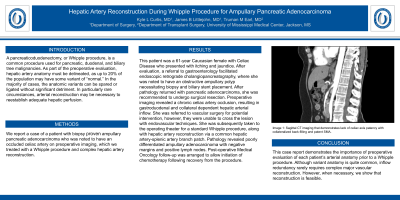Back

HPB
Category: Quickshot Oral Session 12
Quickshot Oral : Quickshot Oral Session 12
HEPATIC ARTERY RECONSTRUCTION DURING WHIPPLE PROCEDURE FOR AMPULLARY PANCREATIC ADENOCARCINOMA
Sunday, February 12, 2023
7:00am – 8:00am East Coast USA Time


Kyle Curtis, MD
Resident
University of MIssissippi Medical Center, United States
Kyle Curtis, MD
Resident
University of MIssissippi Medical Center, United States
Presenter(s)
Principal Contact(s)
Objectives: A pancreaticoduodenectomy, or Whipple procedure, is a common procedure used for pancreatic, duodenal, and biliary tree malignancies. As part of the preoperative evaluation, hepatic artery anatomy must be delineated, as up to 20% of the population may have some variant of “normal.” In the majority of cases, the anatomic variants can be spared or ligated without significant detriment. In particularly rare circumstances, arterial reconstruction may be necessary to reestablish adequate hepatic perfusion.
Methods: We report a case of a patient with biopsy proven ampullary pancreatic adenocarcinoma who was noted to have an occluded celiac artery on preoperative imaging, which we treated with a Whipple procedure and complex hepatic artery reconstruction.
Results: This patient was a 61-year Caucasian female with Celiac Disease who presented with itching and jaundice. After evaluation, a referral to gastroenterology facilitated endoscopic retrograde cholangiopancreatography, where she was noted to have an obstructive ampullary polyp necessitating biopsy and biliary stent placement. After pathology returned with pancreatic adenocarcinoma, she was recommended to undergo surgical resection. Preoperative imaging revealed a chronic celiac artery occlusion, resulting in gastroduodenal and collateral dependent hepatic arterial inflow. She was referred to vascular surgery for potential intervention, however, they were unable to cross the lesion with endovascular techniques. She was subsequently taken to the operating theater for a standard Whipple procedure, along with hepatic artery reconstruction via a common hepatic artery-splenic artery branch patch. Pathology revealed poorly differentiated ampullary adenocarcinoma with negative margins and positive lymph nodes. Post-operative Medical Oncology follow-up was arranged to allow initiation of chemotherapy following recovery from the procedure.
Conclusion: This case report demonstrates the importance of preoperative evaluation of each patient’s arterial anatomy prior to a Whipple procedure. Although variant anatomy is quite common, inflow redundancy rarely requires complex major vascular reconstruction. However, when necessary, we show that reconstruction is feasible.
Methods: We report a case of a patient with biopsy proven ampullary pancreatic adenocarcinoma who was noted to have an occluded celiac artery on preoperative imaging, which we treated with a Whipple procedure and complex hepatic artery reconstruction.
Results: This patient was a 61-year Caucasian female with Celiac Disease who presented with itching and jaundice. After evaluation, a referral to gastroenterology facilitated endoscopic retrograde cholangiopancreatography, where she was noted to have an obstructive ampullary polyp necessitating biopsy and biliary stent placement. After pathology returned with pancreatic adenocarcinoma, she was recommended to undergo surgical resection. Preoperative imaging revealed a chronic celiac artery occlusion, resulting in gastroduodenal and collateral dependent hepatic arterial inflow. She was referred to vascular surgery for potential intervention, however, they were unable to cross the lesion with endovascular techniques. She was subsequently taken to the operating theater for a standard Whipple procedure, along with hepatic artery reconstruction via a common hepatic artery-splenic artery branch patch. Pathology revealed poorly differentiated ampullary adenocarcinoma with negative margins and positive lymph nodes. Post-operative Medical Oncology follow-up was arranged to allow initiation of chemotherapy following recovery from the procedure.
Conclusion: This case report demonstrates the importance of preoperative evaluation of each patient’s arterial anatomy prior to a Whipple procedure. Although variant anatomy is quite common, inflow redundancy rarely requires complex major vascular reconstruction. However, when necessary, we show that reconstruction is feasible.

